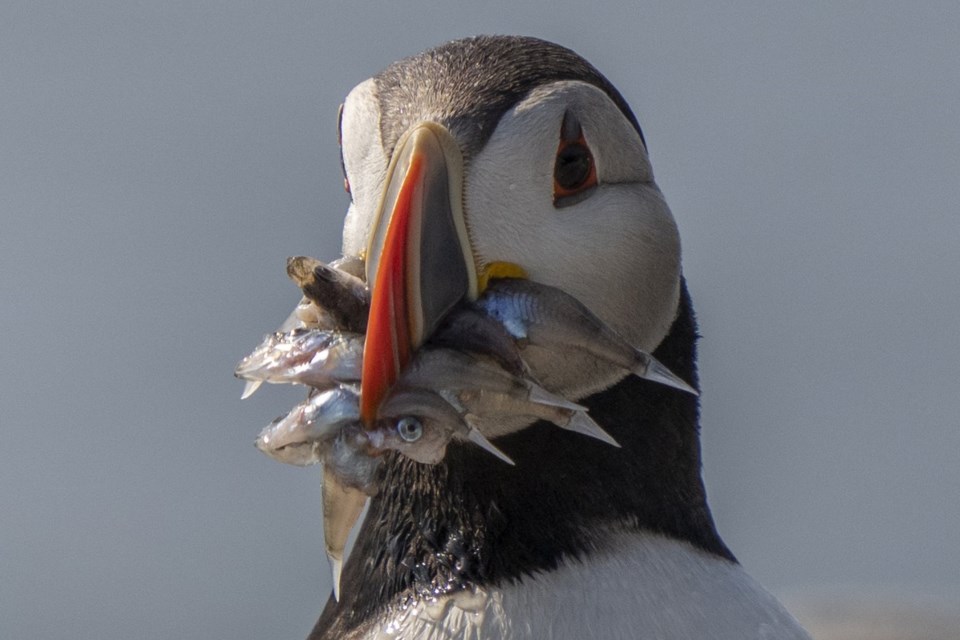FREDERICTON — The puffins of Machias Seal Island are feeling the heat.
Scientists say there is a link between warming waters and changes in the birds' size and their beaks, as well as fluctuations in reproduction and the survival of chicks.
Machias Seal Island is a flat, treeless piece of rock located about 19 kilometres southwest of New Brunswick's Grand Manan Island at the mouth of the Bay of Fundy. It is a sanctuary for seabirds, including about 8,600 breeding pairs of puffins.
Heather Major, a marine biology professor at the University of New Brunswick, and her team are studying puffins and other birds on the island with a focus on the impacts of climate change.
Data on puffins on Machias Seal Island have been collected since 1995 and one of the most notable observations made by scientists is that when the birds are old enough to leave the island to go to sea, they are smaller than they used to be.
"We don't know what that means for their survival, or their probability of returning as adults," Major said in a video interview last week from the island.
"And that's really interesting because that is one of the changes that you expect to see in a warming environment. A smaller body size means you're able to dump heat more effectively."
As Major spoke outside the research centre, razorbills, common murres, Arctic terns and other birds flew behind her, keeping up a stream of chirps and trills.
Over the past 10 years, she said, scientists have noted the puffins' hatch date has become later, with chicks emerging toward the end of June rather than mid-June. And the birds' distinctive brightly coloured beaks — which they use to carry fish and possibly to attract mates — are getting larger, she said.
The reason for the bigger beaks is unclear, but one hypothesis is that puffins may be using them to get rid of body heat; the larger the beak the more heat that can be shed.
On average, Major said, about 55 per cent of the island's puffin chicks survive to go out into the ocean at the end of summer. Many then return to the island as adults to breed.
Over the past 10 years, scientists have seen a concerning trend, as the number of birds making it out to sea fluctuates wildly.
"What's happening is that we're getting these really, really good years followed by really, really bad years," Major said. "We see these really big fluctuations that we don't see earlier in the data set, and that seems to be related to things that are happening in the ocean."
Puffins can live up to 30 years, and a stable population requires each pair successfully produce two chicks that survive to adulthood, which works out to one chick every few years. So far, that threshold is being met. But Major worries that if the fluctuations continue, the puffin population may start to fall.
The drops in reproductive success coincide with years where the ocean was "really" warm, which leads to a decrease in food for the chicks, she said.
Puffins are listed as "vulnerable" by the International Union for Conservation of Nature, which means they face a high risk of extinction in the wild.
Andrew Allyn, a researcher at the Gulf of Maine Research Institute, said the waters in the region have warmed by about 1.6 C since the 1980s, with the area heating up most during the summer. He said the region has seen marine heat waves over the past 10 to15 years.
"Marine heat wave events at the surface are becoming more frequent, more intense, and longer lasting, both globally and in the Gulf of Maine," he said.
Major said a favoured food for puffins is Atlantic herring, which is rich in fat and helps chicks grow enough to be able to leave the island. But scientists are seeing less herring in chicks' diets and more prey with a lower energy content, such as squid and sand eels.
"It's interesting because it could be that there's herring out there, but that for some reason, the puffins can't find it," she said.
Allyn said just as humans adapt their behaviour on land when temperatures soar — cranking on the air conditioner or jumping in the water to cool off — marine species may have similar coping mechanisms. For example, he said herring might choose to temporarily seek out cooler, or deeper waters and then limit their movements, which could explain why puffins can't find them.
Major and her team have put tracking tags on puffins to see how far out the birds are going to get their food, including how deep they have to dive. It is stressful for parents to have to search further and dive deeper to find fish for their chicks, carrying the food in their beaks back to the chicks, she said.
"It adds more energy that the adults have to spend, and then reduces their body condition and can impact their survival."
This report by The Canadian Press was first published July 28, 2024.
Hina Alam, The Canadian Press



